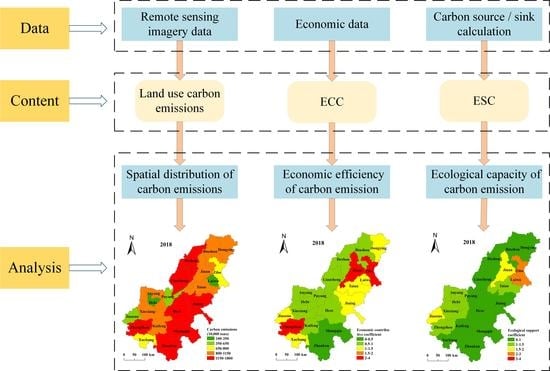Carbon Dioxide Emissions and Their Driving Forces of Land Use Change Based on Economic Contributive Coefficient (ECC) and Ecological Support Coefficient (ESC) in the Lower Yellow River Region (1995–2018)
Abstract
1. Introduction
2. Material and Methods
2.1. Study Area
2.2. Data Sources
- Statistical yearbook data: This study obtained GDP, population, per capita GDP, and tertiary industry contribution to GDP for the 20 prefecture-level cities in the lower Yellow River area for 1995, 2005, 2010, and 2018. The data for 1995, 2005, and 2010 were from the 1996, 2006, and 2011 Henan Statistical Yearbook and the Shandong Statistical Yearbook. Social data for 2018 were obtained from the statistical websites of the investigated cities (Table S1) (Note: This study standardized the data before analysis).
- Remote sensing imagery data: Remote sensing imagery data were obtained from the Resource and Environmental Science Data Center of the Chinese Academy of Sciences (http://www.resdc.cn).
2.3. Methods
2.3.1. Dynamic Degree of Land Use
2.3.2. Carbon Emission/Absorption Model of Land Use
- The land use carbon emissions of cultivated land, woodland, water area, and unused land, other than built-up land, were calculated as [49]:where EUce is the land use carbon emissions, Si is the area of the i-th land type, and εi is the carbon emission coefficient per unit area corresponding to the i-th land use type. Positive values represent emissions and negative values represent absorption. Table 1 presents the carbon emission coefficients of each land use type, except built-up area, as previously calculated [53].
- The carbon emissions of built-up land were calculated by multiplying the area of built-up land with carbon sources and sinks, as follows [50]:where EUcb is the carbon emission of built-up land, ξi is the carbon source coefficient of built-up land, 56.46 t/hm2·a (ton/square hectometer·annually), and δi is the carbon sink coefficient of built-up land, 2.38 t/hm2·a.
- Based on Equations (2) and (3), the total land use carbon emission was obtained, as follows:where EU is the total carbon emission, EUce is the carbon emission of land use other than built-up land, and EUcb is the carbon emission of built-up land.
2.3.3. Carbon Emission Equity Evaluation Model
Economic Efficiency Model of Carbon Emission
Ecological Pressure Model of Carbon Emission
2.3.4. STIRPAT Model
2.3.5. Ordinary Least Squares
3. Results
3.1. Land Use Changes
3.2. Spatiotemporal Trends in Land Use Carbon Emissions
3.3. ECC and ESC of Carbon Emissions
3.3.1. ECC of Carbon Emissions
3.3.2. ESC of Carbon Emissions
3.4. STIRPAT Model Results
4. Discussion
5. Conclusions
Supplementary Materials
Author Contributions
Funding
Conflicts of Interest
References
- Sohl, T.L.; Sleeter, B.M.; Zhu, Z.L.; Sayler, K.L.; Bennett, S.; Bouchard, M.; Reker, R.; Hawbaker, T.; Wein, A.; Liu, S.G.; et al. A Land use and land-cover modeling strategy to support a national assessment of carbon stocks and fluxes. Appl. Geogr. 2012, 34, 111–124. [Google Scholar] [CrossRef]
- Deng, X.Z. Net Energy, CO2 Emission and Land-Based Cost-Benefit Analyses of Jatropha Biodiesel: A case study of the Panzhihua region of Sichuan Province in China. Energies 2012, 5, 2150–2164. [Google Scholar] [CrossRef]
- Wang, S.J.; Fang, C.L.; Guan, X.L.; Pang, B.; Ma, H.T. Urbanisation, energy consumption, and carbon dioxide emissions in China: A panel data analysis of China’s provinces. Appl. Energy 2014, 136, 738–749. [Google Scholar] [CrossRef]
- Yang, J.; Guo, A.D.; Li, Y.H.; Zhang, Y.Q.; Li, X.M. Simulation of landscape spatial layout evolution in rural-urban fringe areas: A case study of Ganjingzi District. GISci. Remote Sens. 2019, 56, 388–405. [Google Scholar] [CrossRef]
- Yu, Z.; Lu, C.Q.; Tian, H.Q.; Canadell, J.G. Largely underestimated carbon emission from land use and land cover change in the conterminous United States. Glob. Change Biol. 2019, 25, 3741–3752. [Google Scholar] [CrossRef]
- Zhang, P.Y.; He, J.J.; Hong, X.; Zhang, W.; Qin, C.Z.; Pang, B.; Li, Y.Y.; Liu, Y. Regional-level carbon emissions modelling and scenario analysis: A STIRPAT case study in Henan Province, China. Sustainability 2017, 9, 2342. [Google Scholar] [CrossRef]
- Zhang, P.Y.; He, J.J.; Hong, X.; Zhang, W.; Qin, C.Z.; Pang, B.; Li, Y.Y.; Liu, Y. Carbon sources/sinks analysis of land use changes in China based on data envelopment analysis. J. Clean Prod. 2018, 204, 702–711. [Google Scholar] [CrossRef]
- Wang, H.M.; Wang, G.Q.; Qi, J.C.; Schandl, H.; Li, Y.M.; Feng, C.Y.; Yang, X.C.; Wang, Y.; Wang, X.Z.; Liang, S. Scarcity-weighted fossil fuel footprint of China at the provincial level. Appl. Energy 2020, 258, 114081. [Google Scholar] [CrossRef]
- Li, L.; Huang, X.J.; Yang, H.; Chuai, X.W.; Zhang, M.; Zhong, T.Y.; Chen, Z.G.; Chen, Y.; Wang, X.; Thompson, J.R. Carbon emissions from land use change and management in China between 1990 and 2010. Sci. Adv. 2016, 2, e1601063. [Google Scholar] [CrossRef]
- Yang, H.R.; Zheng, H.; Liu, H.G.; Wu, Q. NonLinear effects of environmental regulation on eco-efficiency under the constraint of land use carbon emissions: Evidence based on a bootstrapping approach and Panel Threshold Model. Int. J. Environ. Res. Public Health 2019, 16, 1679. [Google Scholar] [CrossRef]
- Li, Z.G.; Zhong, J.L.; Sun, Z.S.; Yang, W.N. Spatial pattern of carbon sequestration and urban sustainability: Analysis of land use and carbon emission in Guang’an, China. Sustainability 2017, 9, 1951. [Google Scholar] [CrossRef]
- Hutyra, L.R.; Yoon, B.; Alberti, M. Terrestrial carbon stocks across a gradient of urbanization: A study of the Seattle, WA region. Glob. Change Biol. 2011, 17, 783–797. [Google Scholar] [CrossRef]
- Song, T.; Wang, Y.S. Carbon dioxide fluxes from an urban area in Beijing. Atmos. Res. 2012, 106, 139–149. [Google Scholar] [CrossRef]
- Xu, Q.; Dong, Y.X.; Yang, R. Urbanization impact on carbon emissions in the Pearl River Delta region: Kuznets curve relationships. J. Clean Prod. 2018, 180, 514–523. [Google Scholar] [CrossRef]
- Sitch, S.; Friedlingstein, P.; Gruber, N.; Jones, S.D.; Murray-Tortarolo, G.; Ahlström, A.; Doney, S.C.; Graven, H.; Heinze, C.; Huntingford, C.; et al. Recent trends and drivers of regional sources and sinks of carbon dioxide. Biogeosciences 2015, 12, 653–679. [Google Scholar] [CrossRef]
- Houghton, R.A. Magnitude, Distribution and causes of terrestrial carbon sinks and some implications for policy. Clim. Policy 2002, 2, 71–88. [Google Scholar] [CrossRef]
- Houghton, R.A.; House, J.I.; Pongratz, J.; van der Werf, G.R.; DeFries, R.S.; Hansen, M.C.; Le Quéré, C.; Ramankutty, N. Carbon emissions from land use and land-cover change. Biogeosciences 2012, 9, 5125–5142. [Google Scholar] [CrossRef]
- Houghton, R.A.; Hackler, J.L. Sources and sinks of carbon from land use change in China. Glob. Biogeochem. Cycle 2003, 17, 1034–1047. [Google Scholar] [CrossRef]
- Zhang, C.; Tian, H.Q.; Chen, G.S.; Chappelka, A.; Xu, X.F.; Ren, W.; Hui, D.F.; Liu, M.L.; Lu, C.Q.; Pan, S.F.; et al. Impacts of urbanization on carbon balance in terrestrial ecosystems of the Southern United States. Environ. Pollut. 2012, 164, 89–101. [Google Scholar] [CrossRef]
- Chuai, X.W.; Lai, L.; Huang, X.J.; Zhao, R.Q.; Wang, W.J.; Chen, Z.G. Temporospatial changes of carbon footprint based on energy consumption in China. J. Geogr. Sci. 2012, 22, 110–124. [Google Scholar] [CrossRef]
- Schipper, L.; Murtishaw, S.; Khrushch, M.; Ting, M.; Karbuz, S.; Unander, F. Carbon emissions from manufacturing energy use in 13 IEA countries: Long-term trends through 1995. Energy Policy 2001, 29, 667–688. [Google Scholar] [CrossRef]
- Ali, G.; Nitivattananon, V. Exercising multidisciplinary approach to assess interrelationship between energy use, carbon emission and land use change in a metropolitan city of Pakistan. Renew. Sustain. Energy Rev. 2012, 16, 775–786. [Google Scholar] [CrossRef]
- Zhu, Q.; Peng, X.Z.; Lu, Z.M.; Wu, K.Y. Factors decomposition and empirical analysis of variations in energy carbon emission in China. Resour. Sci. 2009, 31, 2072–2079. [Google Scholar]
- Wang, C.; Chen, J.; Zou, J. Decomposition of energy-related CO2 emission in China: 1957–2000. Energy 2005, 30, 73–83. [Google Scholar] [CrossRef]
- Tan, Z.F.; Li, L.; Wang, J.; Wang, J.H. Examining the driving forces for improving China’s CO2 emission intensity using the decomposing method. Appl. Energy 2011, 88, 4496–4504. [Google Scholar] [CrossRef]
- Guo, Y.G.; Lin, F.C.; Bai, Y.Q.; Wu, M.M. The decomposition research on energy-related carbon emissions of Shanghai. Chin. J. Environ. Pollut. Prot. 2009, 31, 68–72. [Google Scholar]
- Liu, C.L.; Chen, C.C.; Chen, Q.; Zhu, S.L.; Wang, H.H.; Li, Z. Evolution mechanisms of CO2 emissions in Beijing City during the period 1997–2007. Resour. Sci. 2010, 32, 235–241. [Google Scholar]
- Shi, A. The impact of population pressure on global carbon dioxide emissions, 1975–1996: Evidence from pooled cross-country data. Ecol. Econ. 2003, 44, 29–42. [Google Scholar] [CrossRef]
- Fan, Y.; Liu, L.C.; Wu, G.; Wei, Y.M. Analyzing impact factors of CO2 emissions using the STIRPAT model. Environ. Impact Assess. Rev. 2006, 26, 377–395. [Google Scholar] [CrossRef]
- Wang, Z.; Yin, F.; Zhang, Y.; Zhang, X. An empirical research on the influencing factors of regional CO2 emissions: Evidence from Beijing city, China. Appl. Energy 2012, 100, 277–284. [Google Scholar] [CrossRef]
- Greening, L.A.; Ting, M.; Krackler, T.J. Effects of changes in residential end-use and behavior on aggregate carbon emission intensity: Comparison of 100 OECD countries for the period 1970 through 1993. Energy Econ. 2001, 23, 153–178. [Google Scholar] [CrossRef]
- Singh, M.K.; Mukherjee, D. Drivers of greenhouse gas emissions in the United States: Revisiting STIRPAT model. Environ. Dev. Sustain. 2019, 21, 3015–3031. [Google Scholar] [CrossRef]
- Stern, D.I.; Jotzo, F. How ambitious are China and India’s emissions intensity targets? Energy Policy 2010, 38, 6776–6783. [Google Scholar] [CrossRef]
- Zhao, R.Q.; Huang, X.J.; Liu, Y.; Zhong, T.Y.; Ding, M.L.; Chuai, X.W. Carbon emission of regional land use and its decomposition analysis: Case study of Nanjing City, China. Chin. Geogr. Sci. 2015, 25, 198–212. [Google Scholar] [CrossRef]
- Ke, Y.; Yi, X. Path selection for low-carbon economic land use pattern in China. Energy Procedia 2011, 5, 452–456. [Google Scholar] [CrossRef][Green Version]
- Sun, X.B. Effects of Carbon emission by land use patterns in Hefei’s economic circle of Anhui Province. J. Nat. Resour. 2012, 27, 394–401. [Google Scholar]
- Chuai, X.W.; Huang, X.J.; Lai, L.; Wang, W.J.; Peng, J.W.; Zhao, R.Q. Land use structure optimization based on carbon storage in several regional terrestrial ecosystems across China. Environ. Sci. Policy 2013, 25, 50–61. [Google Scholar] [CrossRef]
- Liu, Z.; Guan, D.B.; Wei, W.; Davis, S.J.; Ciais, P.; Bai, J.; Peng, S.S.; Zhang, Q.; Hubacek, K.; Marlang, G.; et al. Reduced carbon emission estimates from fossil fuel combustion and cement production in China. Nature 2015, 524, 335–338. [Google Scholar] [CrossRef]
- Zhao, R.Q.; Huang, X.J.; Zhong, T.Y. Research on carbon emission intensity and carbon footprint of different industrial spaces in China. Acta Geogr. Sin. 2010, 65, 1048–1057. [Google Scholar]
- Tian, J.X.; Yang, H.L.; Xiang, P.G.; Liu, D.W.; Li, L. Drivers of agricultural carbon emissions in Hunan Province, China. Environ. Earth Sci. 2016, 75, 121.1–121.7. [Google Scholar] [CrossRef]
- Shi, G.; Ye, P.; Ding, L.; Quinones, A.; Li, Y.; Jiang, N. Spatial-Temporal patterns of land use and cover change from 1990 to 2010: A case study of Jiangsu Province, China. Int. J. Environ. Res. Public Health 2019, 16, 907. [Google Scholar] [CrossRef]
- Gao, L.; Wen, X.; Guo, Y.T.; Gao, T.M.; Wang, Y.; Shen, L. Spatiotemporal variability of carbon flux from different land use and land cover changes: A case study in Hubei Province, China. Energies 2014, 7, 2298–2316. [Google Scholar] [CrossRef]
- Geng, Y.; Zhao, H.Y.; Liu, Z.; Xue, B.; Fujita, T.; Xi, F. Exploring driving factors of energy-related CO2 emissions in Chinese provinces: A case of Liaoning. Energy Policy 2013, 60, 820–826. [Google Scholar] [CrossRef]
- He, J.J.; Zhang, P.Y. Evaluating the coordination of Industrial-Economic development based on anthropogenic carbon emissions in Henan Province, China. Int. J. Environ. Res. Public Health 2018, 15, 1815. [Google Scholar] [CrossRef] [PubMed]
- Abubaker, O.; Ma, Z.G.; Zheng, Z.Y.; Farhan, S. Natural and anthropogenic influences on the recent droughts in Yellow River Basin, China. Sci. Total Environ. 2020, 704, 135428. [Google Scholar]
- Yin, Y.Y.; Tang, Q.H.; Liu, X.C.; Zhang, X.J. Water scarcity under various socio-economic pathways and its potential effects on food production in the Yellow River basin. Hydrol. Earth Syst. Sci. 2017, 21, 791–804. [Google Scholar] [CrossRef]
- Cen, Y.F.; Zhang, P.Y.; Yan, Y.H.; Jing, W.L.; Zhang, Y.; Li, Y.Y.; Yang, D.; Liu, X.; Geng, W.L.; Rong, T.Q. Spatial and Temporal Agglomeration Characteristics and Coupling Relationship of Urban Built-Up Land and Economic Hinterland—A Case Study of the Lower Yellow River, China. Sustainability 2019, 11, 5218. [Google Scholar] [CrossRef]
- Zhang, P.Y.; Qin, C.Z.; Hong, X.; Kang, G.H.; Qin, M.Z.; Yang, D.; Pang, B.; Li, Y.Y.; He, J.J.; Dick, R.P. Risk assessment and source analysis of soil heavy metal pollution from lower reaches of Yellow River irrigation in China. Sci. Total Environ. 2018, 633, 1136–1147. [Google Scholar] [CrossRef]
- Shi, H.X.; Mu, X.M.; Zhang, Y.L.; Lu, M.Q. Effects of different land use patterns on carbon emission in Guangyuan City of Sichuan province. Bull. Soil Water Conserv. 2012, 32, 101–106. (In Chinese) [Google Scholar]
- He, Y.; Li, X.; Li, Q. Analysis on the effect of carbon emissions from different types of land use in Henan. J. Anhui Agric. Sci. 2012, 40, 14049–14051. (In Chinese) [Google Scholar]
- Su, K.; Wei, D.Z.; Lin, W.X. Evaluation of ecosystem services value and its implications for policy making in China—A case study of Fujian province. Ecol. Indic. 2020, 108, 105752. [Google Scholar] [CrossRef]
- Yang, J.; Liu, W.L.; Li, Y.H.; Li, X.M.; Ge, Q.S. Simulating intraurban land use dynamics under multiple scenarios based on fuzzy cellular automata: A case study of Jinzhou district, Dalian. Complexity 2018, 2018, 7202985. [Google Scholar] [CrossRef]
- Peng, W.F.; Zhou, J.M.; Xu, X.L.; Luo, H.L.; Zhao, J.F.; Yang, C.J. Effect of land use changes on the temporal and spatial patterns of carbon emissions and carbon footprints in the Sichuan Province of Western China, from 1990 to 2010. Acta Ecol. Sin. 2016, 36, 7244–7259. (In Chinese) [Google Scholar]
- Gini, C. Measurement of Inequality of Incomes. Econ. J. 1921, 31, 124–126. [Google Scholar] [CrossRef]
- Wang, J.N.; Lu, Y.T.; Zhou, J.S.; Li, Y.; Cao, D. Analysis of China resource-environment Gini coefficient based on GDP. China Environ. Sci. 2006, 26, 111–115. (In Chinese) [Google Scholar]
- Lu, J.Y.; Huang, X.J.; Dai, L.; Chen, Z.G.; Li, Y. Spatiotemporal scale analysis on the equality of energy consumption carbon emission distribution in China. J. Nat. Resour. 2012, 27, 2006–2017. (In Chinese) [Google Scholar]
- Yuan, S.F.; Tang, Y.Y. Spatial differentiation of land use carbon emission in the Yangtze River economic belt based on low carbon perspective. Econ. Geogr. 2019, 39, 190–198. (In Chinese) [Google Scholar]
- Ehrlich, P.R.; Holdren, J.P. Impact of population growth. Science 1971, 171, 1212–1217. [Google Scholar] [CrossRef]
- Thomas, D.; Eugene, A.R. Rethinking the environmental impacts of population, affluence and Technology. Hum. Ecol. Rev. 1994, 1, 277–300. [Google Scholar]
- Li, H.H.; Mu, H.L.; Zhang, M.; Gui, S.S. Analysis of regional difference on impact factors of China’s energy—Related CO2 emissions. Energy 2012, 39, 319–326. [Google Scholar] [CrossRef]
- Huang, R.; Wang, Z.; Ding, G.Q.; Gong, Y.R.; Liu, C.X. Trend prediction and analysis of influencing factors of carbon emissions from energy consumption in Jiangsu province based on STIRPAT model. Geogr. Res. 2016, 35, 781–789. (In Chinese) [Google Scholar]
- Li, H.H.; Mu, H.L.; Zhang, M.; Li, N. Analysis on influence factors of China’s CO2 emissions based on Path-STIRPAT model. Energy Policy 2011, 39, 6906–6911. [Google Scholar] [CrossRef]
- Dempster, A.P.; Schatzoff, M.; Wermuth, N. A Simulation Study of Alternatives to Ordinary Least Squares. J. Am. Stat. Assoc. 1977, 72, 77–91. [Google Scholar] [CrossRef]
- Zhang, P.Y.; Yang, D.; Zhang, Y.; Li, Y.Y.; Liu, Y.; Cen, Y.F.; Zhang, W.; Geng, W.L.; Rong, T.Q.; Liu, Y.; et al. Re-examining the drive forces of China’s industrial wastewater pollution based on GWR model at provincial level. J. Clean. Prod. 2020, 262, 121309. [Google Scholar] [CrossRef]
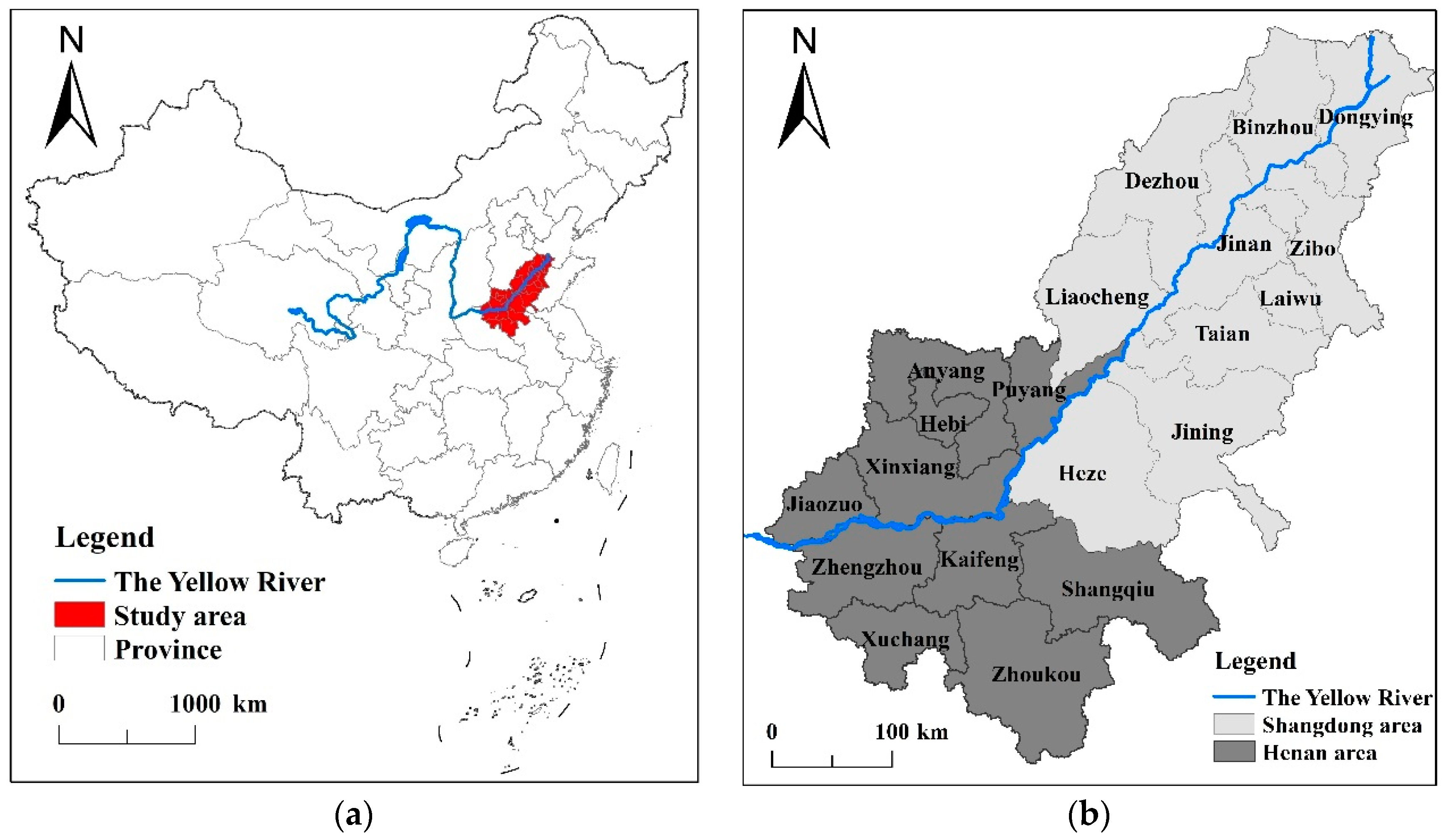
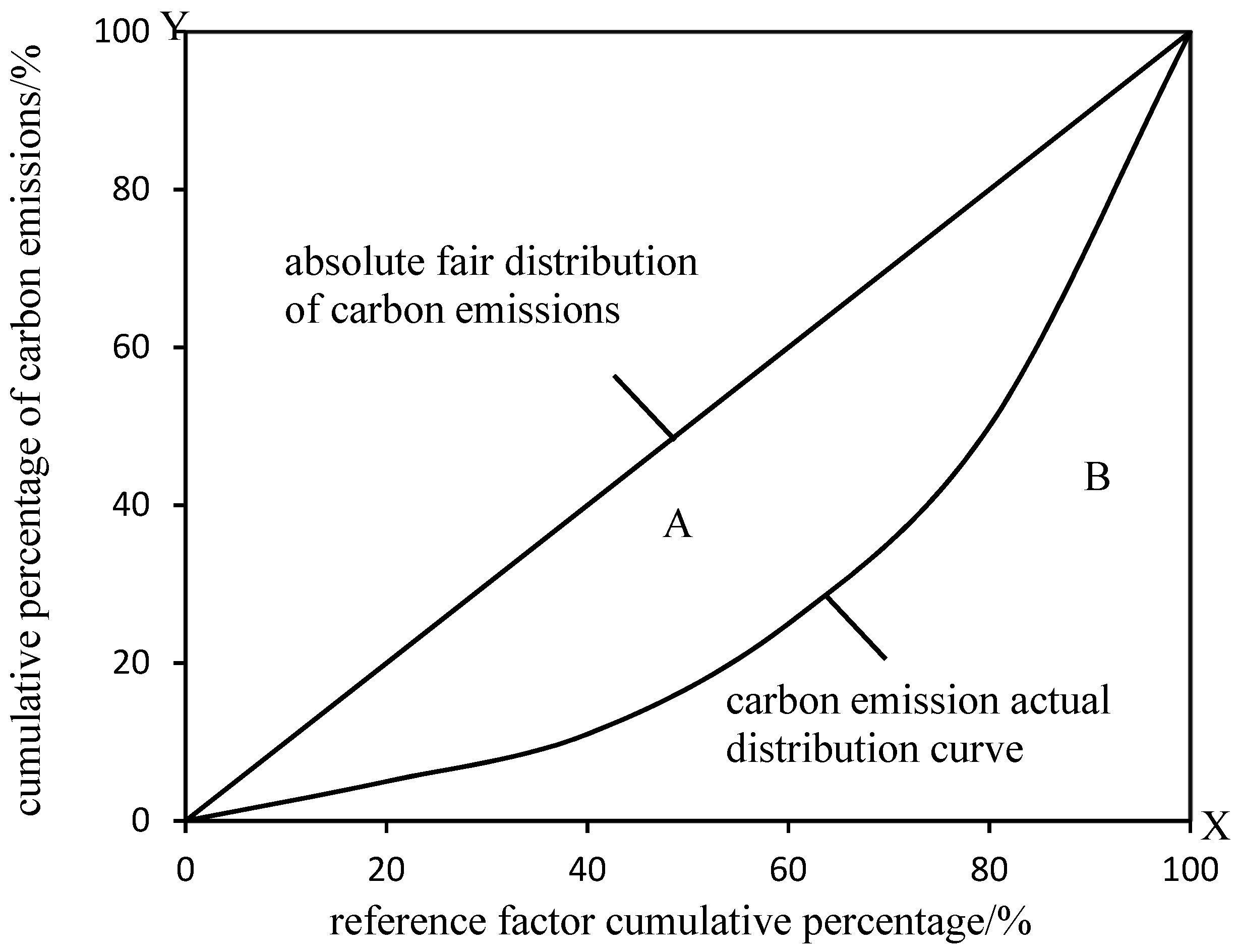
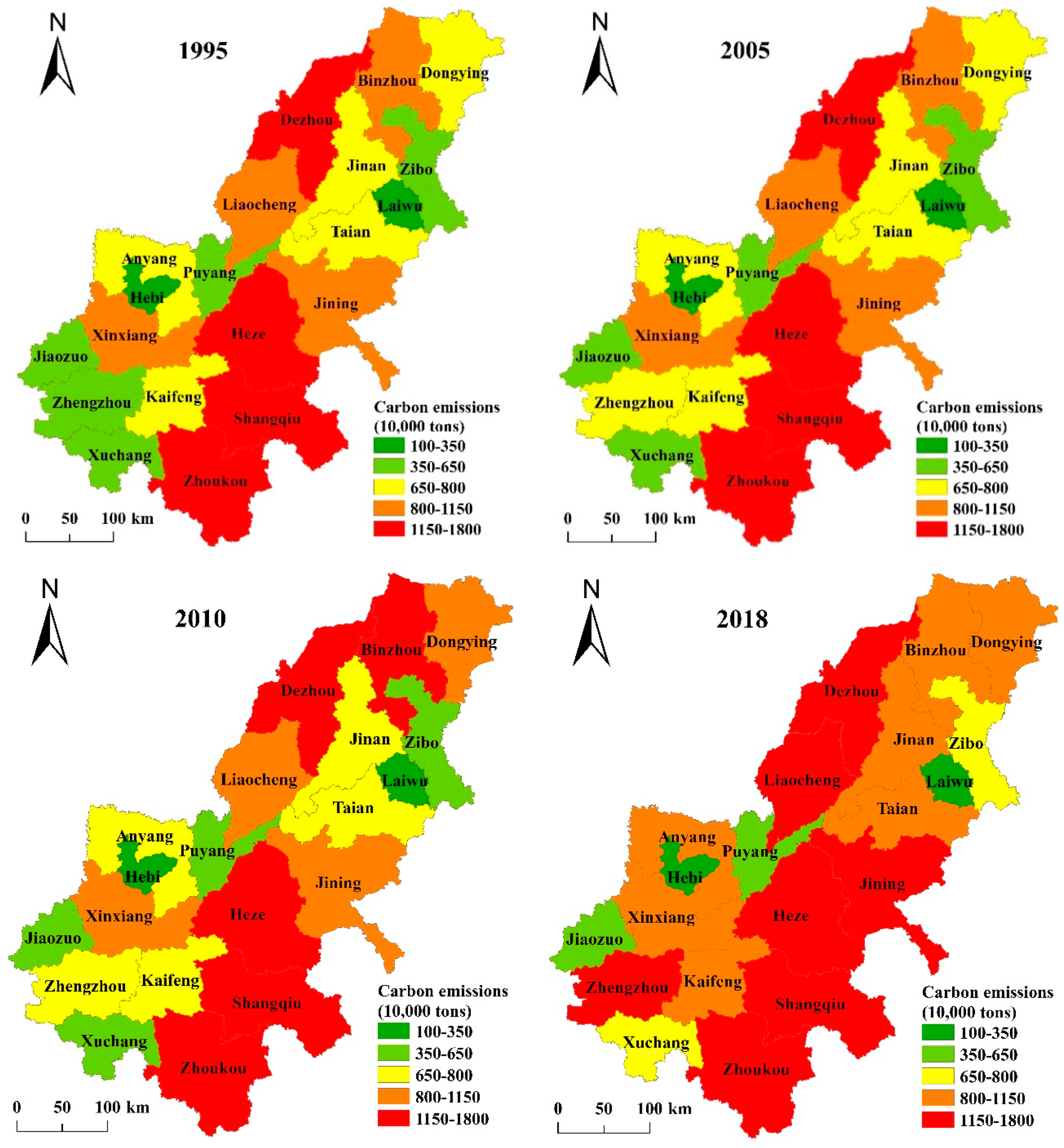
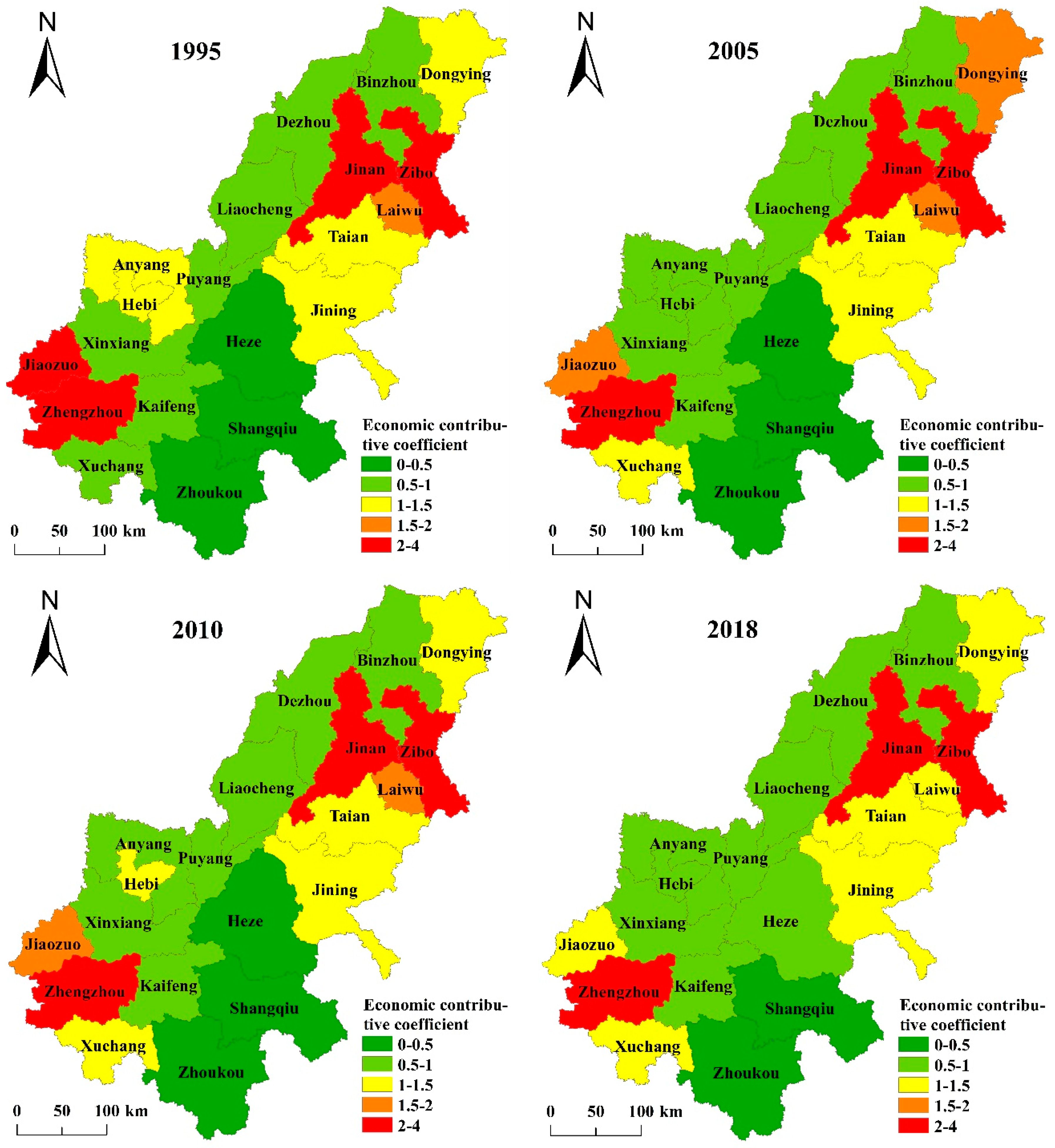
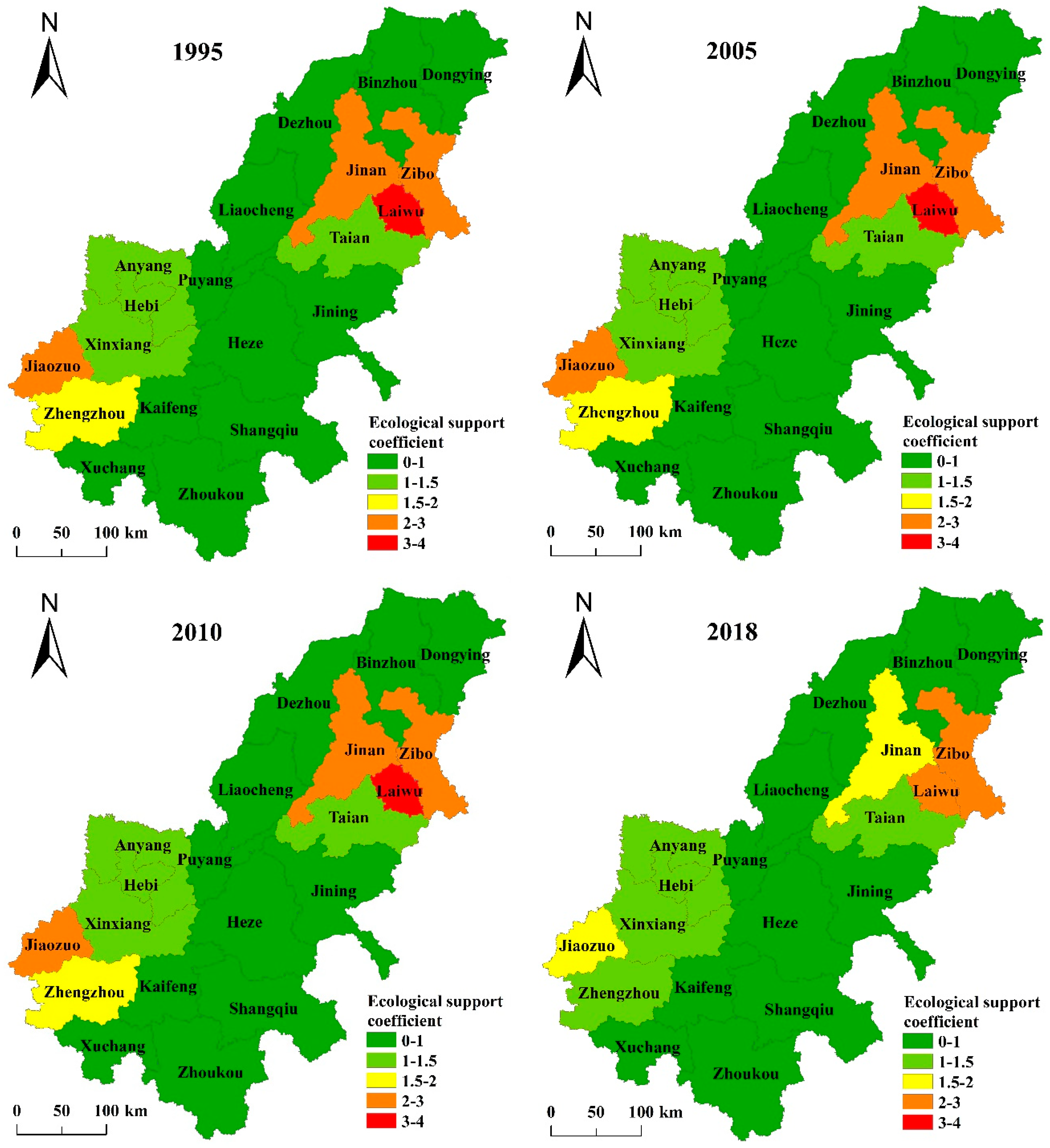
| Land Use Type | Carbon Emission Coefficient (kg/m2·a) |
|---|---|
| Cultivated land | 0.4595 |
| Woodland | −0.6125 |
| Water area | −0.0253 |
| Unused land | −0.0005 |
| Land Use Type | 1995–2005 | 2005–2010 | 2010–2018 | |||
|---|---|---|---|---|---|---|
| Area (km2) | Dynamic Degree (%) | Area (km2) | Dynamic Degree (%) | Area (km2) | Dynamic Degree (%) | |
| Cultivated land | −788 | −0.73 | −819 | −0.76 | −3376 | 3.17 |
| Woodland | −40 | −0.65 | 16 | 0.26 | −692 | −11.23 |
| Water area | 248 | 5.26 | 135 | 2.72 | 1970 | 38.67 |
| Unused land | −539 | −23.62 | −172 | −9.87 | −682 | −43.41 |
| Built-up land | 1712 | 8.08 | 900 | 3.93 | 4637 | 19.48 |
| Region | 2010 | 2018 |
|---|---|---|
| Zhengzhou | 74% | 86% |
| Kaifeng | 70% | 74% |
| Anyang | 70% | 74% |
| Hebi | 70% | 76% |
| Xinxiang | 71% | 75% |
| Jiaozuo | 70% | 78% |
| Puyang | 74% | 78% |
| Shangqiu | 75% | 76% |
| Xuchang | 73% | 76% |
| Zhoukou | 74% | 75% |
| Jinan | 74% | 82% |
| Zibo | 78% | 83% |
| Dongying | 78% | 78% |
| Jining | 71% | 77% |
| Taian | 71% | 76% |
| Laiwu | 72% | 81% |
| Dezhou | 70% | 71% |
| Liaocheng | 73% | 78% |
| Binzhou | 78% | 75% |
| Heze | 74% | 77% |
| Region | 1995 GDP (100 Million Yuan) | 2005 GDP (100 Million Yuan) | 2010 GDP (100 Million Yuan) | 2018 GDP (100 Million Yuan) | GDP Growth from 1995 to 2018 (100 Million Yuan) | Carbon Emission growth from 1995 to 2018 (10,000 Tons) |
|---|---|---|---|---|---|---|
| Zhengzhou | 389.9 | 1660.6 | 4040.9 | 10143.3 | 9753.4 | 650.4 |
| Kaifeng | 123.4 | 408.0 | 927.2 | 2002.2 | 1878.9 | 110.4 |
| Anyang | 189.1 | 557.5 | 1315.6 | 2393.2 | 2204.1 | 125.5 |
| Hebi | 54.8 | 186.2 | 429.1 | 862.0 | 807.1 | 48.0 |
| Xinxiang | 210.3 | 544.2 | 1189.9 | 2526.6 | 2316.3 | 174.9 |
| Jiaozuo | 228.1 | 584.0 | 1245.9 | 2371.5 | 2143.4 | 128.4 |
| Puyang | 122.5 | 384.0 | 775.4 | 1654.5 | 1532.0 | 101.0 |
| Shangqiu | 163.1 | 560.8 | 1143.8 | 2389.0 | 2225.9 | 110.3 |
| Xuchang | 126.1 | 605.5 | 1316.5 | 2830.6 | 2704.6 | 73.0 |
| Zhoukou | 195.1 | 595.5 | 1228.3 | 2687.2 | 2492.1 | 122.1 |
| Jinan | 481.5 | 1876.6 | 3910.5 | 7856.6 | 7375.0 | 406.4 |
| Zibo | 404.5 | 1431.0 | 2866.8 | 5068.4 | 4663.9 | 215.6 |
| Dongying | 229.3 | 1166.1 | 2359.9 | 4152.5 | 3923.2 | 143.5 |
| Jining | 368.2 | 1266.3 | 2542.8 | 4930.6 | 4562.4 | 319.2 |
| Taian | 205.2 | 855.7 | 2051.7 | 3651.5 | 3446.4 | 185.0 |
| Laiwu | 69.2 | 256.3 | 546.3 | 1005.7 | 936.5 | 71.3 |
| Dezhou | 184.4 | 831.8 | 1657.8 | 3380.3 | 3195.9 | 124.9 |
| Liaocheng | 164.5 | 693.1 | 1622.4 | 3152.2 | 2987.7 | 307.8 |
| Binzhou | 151.8 | 667.3 | 1551.5 | 2640.5 | 2488.7 | 86.2 |
| Heze | 168.5 | 450.9 | 1227.1 | 3078.8 | 2910.3 | 226.1 |
| Variable | Regression Coefficient | Standard Error | t | P |
|---|---|---|---|---|
| α | −0.2133 | 0.0686 | −3.109 | 0.0026 |
| lnP | 0.0098 | 0.008 | 1.232 | 0.2218 |
| lnA | −0.0338 | 0.005 | −6.369 | 0.0000 |
| lnS | 1.024 | 0.0105 | 97.165 | 0.0000 |
| lnI | −0.0511 | 0.0189 | −2.708 | 0.0084 |
© 2020 by the authors. Licensee MDPI, Basel, Switzerland. This article is an open access article distributed under the terms and conditions of the Creative Commons Attribution (CC BY) license (http://creativecommons.org/licenses/by/4.0/).
Share and Cite
Rong, T.; Zhang, P.; Jing, W.; Zhang, Y.; Li, Y.; Yang, D.; Yang, J.; Chang, H.; Ge, L. Carbon Dioxide Emissions and Their Driving Forces of Land Use Change Based on Economic Contributive Coefficient (ECC) and Ecological Support Coefficient (ESC) in the Lower Yellow River Region (1995–2018). Energies 2020, 13, 2600. https://doi.org/10.3390/en13102600
Rong T, Zhang P, Jing W, Zhang Y, Li Y, Yang D, Yang J, Chang H, Ge L. Carbon Dioxide Emissions and Their Driving Forces of Land Use Change Based on Economic Contributive Coefficient (ECC) and Ecological Support Coefficient (ESC) in the Lower Yellow River Region (1995–2018). Energies. 2020; 13(10):2600. https://doi.org/10.3390/en13102600
Chicago/Turabian StyleRong, Tianqi, Pengyan Zhang, Wenlong Jing, Yu Zhang, Yanyan Li, Dan Yang, Jiaxin Yang, Hao Chang, and Linna Ge. 2020. "Carbon Dioxide Emissions and Their Driving Forces of Land Use Change Based on Economic Contributive Coefficient (ECC) and Ecological Support Coefficient (ESC) in the Lower Yellow River Region (1995–2018)" Energies 13, no. 10: 2600. https://doi.org/10.3390/en13102600
APA StyleRong, T., Zhang, P., Jing, W., Zhang, Y., Li, Y., Yang, D., Yang, J., Chang, H., & Ge, L. (2020). Carbon Dioxide Emissions and Their Driving Forces of Land Use Change Based on Economic Contributive Coefficient (ECC) and Ecological Support Coefficient (ESC) in the Lower Yellow River Region (1995–2018). Energies, 13(10), 2600. https://doi.org/10.3390/en13102600





